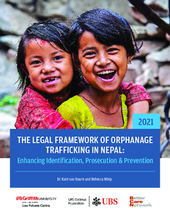Orphanage trafficking is a form of child trafficking, in which children are removed from their families, often under false pretences, and transferred or recruited into child care institutions where they often face various forms of exploitation for profit. When a child is trafficked in this way, their identity is frequently falsified so in documents they appear to be an orphan – a process known as ‘paper orphaning’. The exploitation of children in these circumstances ranges from sexual abuse to forced labour, begging, or being sold for illegal adoption or servitude. Some are trafficked for their organs, while others simply disappear.
From the outset, it is important to acknowledge that Nepal ratified the international law on human trafficking, the Protocol to Prevent, Suppress and Punish Trafficking in Persons, especially Women and Children, in June 2020. Since then, advocates have called for the Nepali government to align the domestic laws on human trafficking with the international protocol. In 2021, the Ministry of Women, Children and Senior Citizens of the Government of Nepal indicated that they are in the process of working to make amendments and to create a National Action Plan for Combatting Human Trafficking. The timeframe for amendment and the National Action Plan is not clear. This report has been drafted based on the current law and policy.
Against this backdrop, this study examines Nepal’s compliance with international legal obligations, its child protection and anti-trafficking laws, and its criminal and procedural laws that regulate illegal transfer and trafficking of children. The study also raises issues regarding victim identification, inspection of child care homes and complaint mechanisms.

